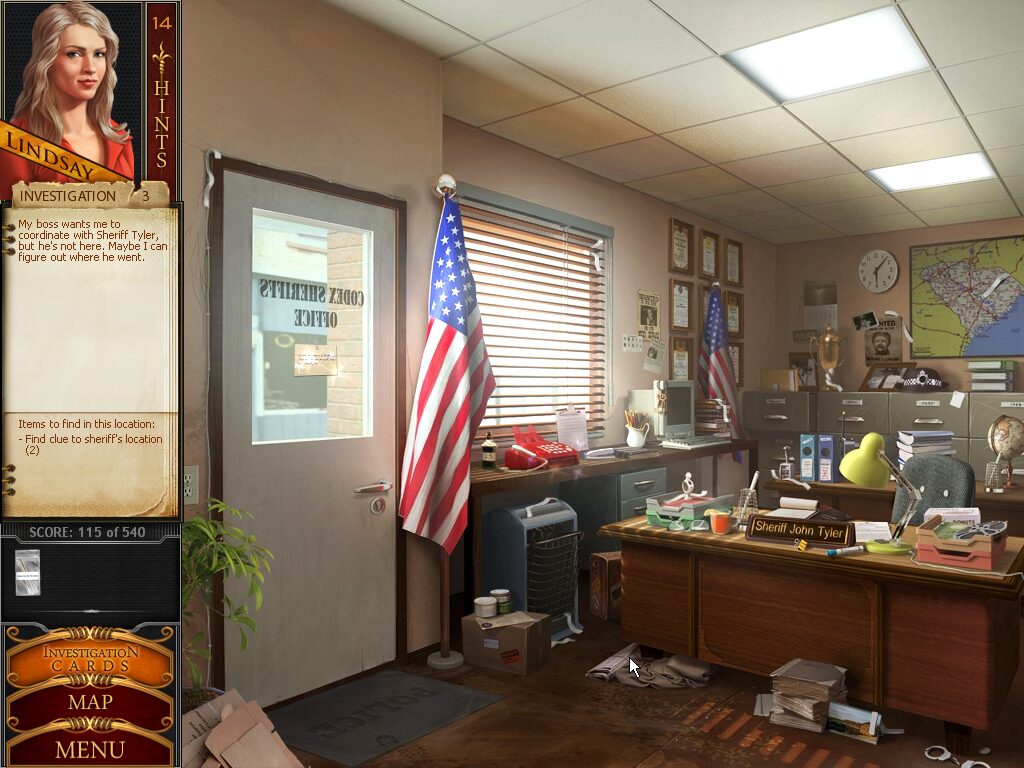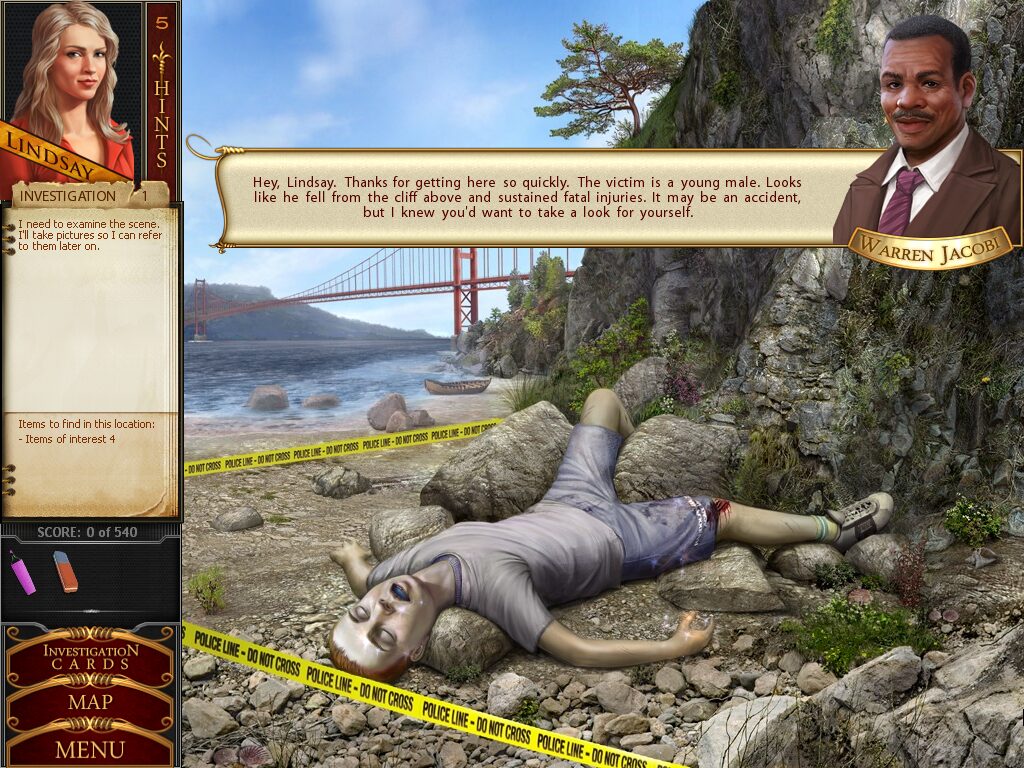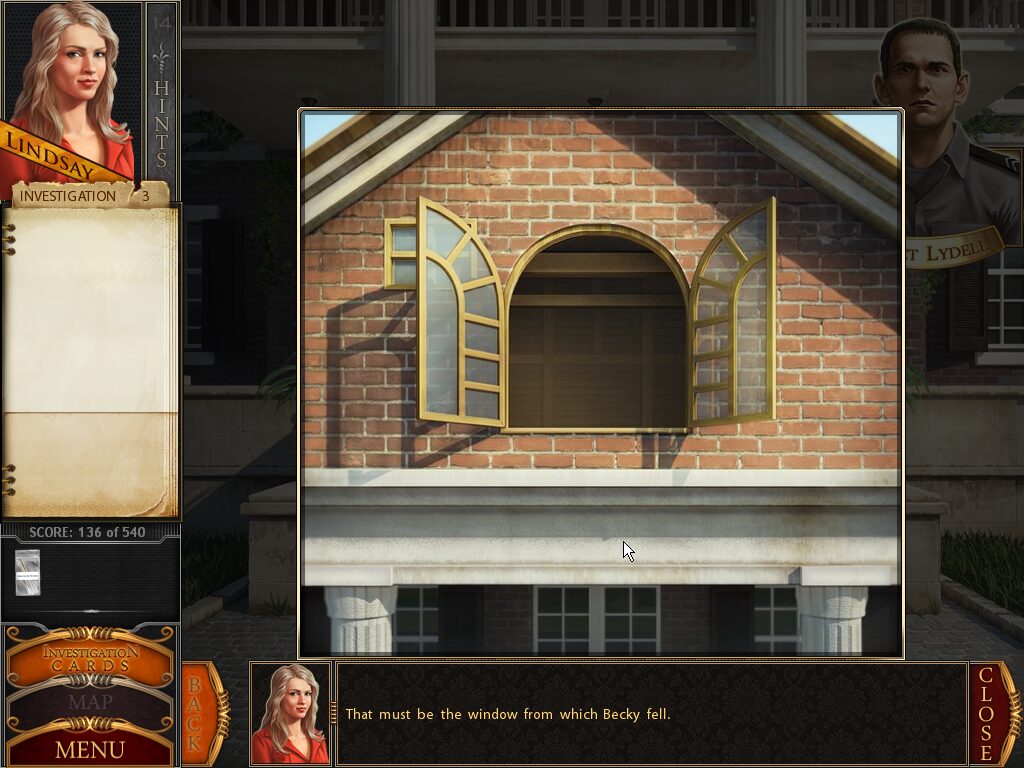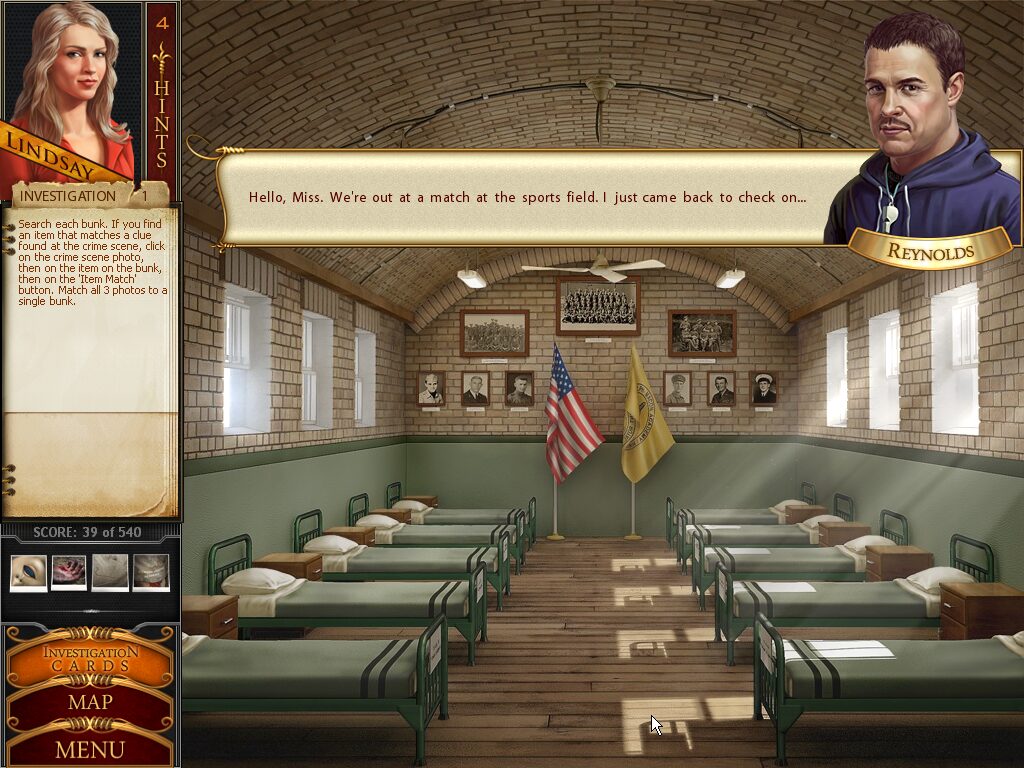Retro Replay Review
Gameplay
Women’s Murder Club: A Darker Shade Of Grey blends classic hidden-object exploration with light adventure mechanics, offering a structured, chapter-based experience. Players toggle between crime scenes, forensic labs, and various Southern locales, each rendered as a clickable panorama littered with “shimmering spots” that uncover clues. The left-side tab organizes your tools: a portrait of the active detective, a hint button with limited uses per chapter, a notepad tracking objectives, and an inventory stocked with forensic instruments. This streamlined interface ensures focus remains on investigation rather than micromanagement.
The core loop revolves around gathering evidence, deciphering forensic data, and solving location-specific puzzles. Upon zooming into a clue spot, you’ll sometimes switch to mini-games — matching flowers to headstones in a cemetery or sorting sports balls on a field — while other times you’ll apply reagents in the lab, carefully measuring drops from rotating shelves. These varied tasks break up the hidden-object routine, injecting fresh challenges at regular intervals.
Pacing is deliberately casual, permitting players to skip tougher puzzles via hint tokens, which recharge each chapter. While seasoned hidden-object veterans might find certain tasks predictable, the occasional brain-teaser – such as calibrating lab instruments or piecing together torn notes – provides a satisfying sense of accomplishment. Overall, the balance between guided investigation and hands-on problem solving makes the gameplay approachable for newcomers and series fans alike.
Replay value stems from both optional bonus objectives and a scoring system that tallies points for speed and thoroughness. Although you can breeze through once for the story, aiming for a perfect score encourages closer scrutiny of every scene. For casual gamers seeking a leisurely mystery, or aficionados of Jane Jensen’s design, the interplay of hidden-object hunts and forensic mini-games delivers an engaging, if not groundbreaking, detective adventure.
Graphics
The visual presentation in A Darker Shade Of Grey leans into atmospheric still-scenes accented by subtle animations. Backgrounds feature richly detailed environments – moss-covered gravestones, peeling paint in dormitory hallways, and the sleek surfaces of a modern forensic lab. While not photo-realistic, the hand-painted style thrives on chiaroscuro lighting, casting suspects’ silhouettes in shadow and imbuing each scene with a moody, Southern Gothic ambiance.
Character portraits and interface elements remain crisp and clear, ensuring that context menus, inventory icons, and the notepad text are always legible. The left tab’s UI is unobtrusive yet immediately accessible, allowing quick item selection and hint activation. Transitions between rooms and mini-games are animated with subtle fades or slide-ins, maintaining immersion without cumbersome loading times or jarring cuts.
Puzzles within zoomed windows showcase brighter color palettes and sharper contrast to highlight interactive hotspots. Forensic mini-games, in particular, make good use of visual feedback: a correct reagent drops in a glowing arc, while misaligned lab bottles momentarily flash red. These cues assist players in developing intuition for puzzle mechanics, reducing reliance on hints without compromising the challenge.
Although the overall engine lacks high-end effects like dynamic shadows or particle simulations, the aesthetic choice aligns perfectly with the game’s casual mystery tone. Background ambient sounds – distant thunder, murmured conversations, and creaking floorboards – complement the visuals, strengthening the sense of place. In sum, the graphics strike a fine balance between stylized art and functional clarity, ideal for a hidden-object adventure.
Story
A Darker Shade Of Grey revolves around a tight-knit team of female investigators from the Women’s Murder Club, united by their tenacity and diverse expertise. When a promising cadet from a prestigious Southern military academy is found dead under suspicious circumstances, these protagonists must navigate institutional politics, personal secrets, and a labyrinth of forensic evidence to reveal the killer’s identity. The plot unfolds in episodic chapters, each ending on a suspenseful note that propels you forward.
Jane Jensen’s narrative design shines through in well-constructed dialogue and character interactions. You’ll interview academy staff, cross-examine witnesses, and occasionally clash with superiors who want the case closed swiftly. Though the writing occasionally leans on genre tropes – the secretive commanding officer, an informant with shady motives – it delivers enough twists and moral quandaries to keep players invested. The camaraderie among the women investigators adds emotional heft, as they each contribute unique skills and personal insights.
Cutscenes are presented as static or minimally animated frames, accompanied by voiceovers that give each detective a distinct personality. While full animation would boost immersion, the current approach keeps production costs manageable and preserves the game’s quick-to-load, pick-up-and-play nature. Story clues integrate seamlessly with gameplay: reading a cadet’s journal might unlock new search areas, while lab results steer you toward fresh leads.
Subplots involving academy politics and regional traditions lend depth to the mystery, weaving in themes of privilege, loyalty, and the price of ambition. Though the final reveal follows familiar detective-story beats, it’s executed with enough finesse – thanks partly to Jensen’s scripting – to satisfy casual gamers looking for a self-contained mystery, as well as series veterans anticipating a clever twist.
Overall Experience
Women’s Murder Club: A Darker Shade Of Grey offers a comfortably paced, genre-blending detective adventure ideal for casual players and hidden-object enthusiasts. Its interface is intuitive, gameplay loops are varied, and the story maintains a steady tension without overwhelming newcomers. Jane Jensen’s design expertise is evident in the thoughtful integration of mini-games, forensic puzzles, and narrative beats.
While the graphics and audio design opt for stylized simplicity over high-end spectacle, they complement the game’s focus on investigation rather than action. Beginners will appreciate the forgiving hint system and clear objective tracking, while completionists can chase high scores and uncover every hidden clue. Each chapter concludes with enough narrative closure to feel rewarding, yet leaves just enough unanswered questions to carry you to the next scene.
Some may find the puzzles occasionally predictable, and those seeking intense challenge might breeze through the hidden-object searches. However, the balance between accessibility and engagement makes this title a dependable pick for afternoon mystery sessions. The camaraderie of the all-female investigative team, combined with Southern locale details, lends a fresh flavor to a familiar format.
In the end, A Darker Shade Of Grey succeeds as a polished, user-friendly mystery romp. It neither reinvents the hidden-object genre nor aspires to blockbuster production values, but it delivers on its promise: a compelling investigation packed with neat puzzles, atmospheric settings, and a satisfying whodunit narrative. For fans of casual detective games, this entry is a worthy addition to the Women’s Murder Club lineup.
 Retro Replay Retro Replay gaming reviews, news, emulation, geek stuff and more!
Retro Replay Retro Replay gaming reviews, news, emulation, geek stuff and more!









Reviews
There are no reviews yet.